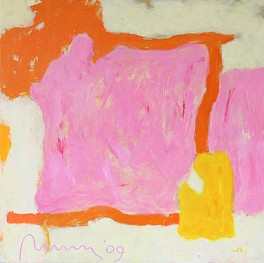BIOGRAPHY

Ruud Bergmans' destiny was shaped by an experience more than 50 years before he would realize its full impact. The result is the first public exhibition of the artist's work, currently on view at Old Lyme's Cooley Gallery.
It was 1956, and Bergmans was 16 years old. He was living in Holland, his native country, when he saw a Time magazine cover featuring a painting by the Dutch abstract expressionist painter Willem de Kooning.
"It took my breath away," Bergmans says. "It was such an 'aha' moment for me. There was no Google (to look deKooning up). He was not very well known at that time."
Bergmans, who resides with his wife in New York and Old Lyme, says his family was always interested in art, but "for them, the Dutch Masters were everything."
Seeing de Kooning's work, "opened my eyes to a new area of art and (since then) my preference has always been modern art," he says.
Bergmans says he, too, loves the Dutch Masters, but realized as a teenager that there were a lot of other equally "really cool" mediums and styles of art to explore.
Although he became an avid art appreciator, he didn't become a painter in his own right until retiring from a career in banking.
In 1980, at 40 years old, Bergmans moved to Manhattan and started taking drawing classes at the Art Students League of New York, which he continues to do four or five mornings a week.
"I loved it," he says. Two years before I retired (15 years ago) I said, 'This is what I'm going to do.'
And he hasn't stopped since, creating playful, imaginative color-drenched canvases that pull the viewer into their abstracted landscapes and sensuous shapes. Close to 60 paintings are in the Cooley Gallery show, mostly painted within the last two years.
"Green Tomatoes," feels like summer. One can almost taste "Strawberry Parfait." The brilliant red line in "Farm Country" practically vibrates off the canvas.
"I'm a colorist," Bergmans says. "That's my thing." Although he says he also likes to work in black and white.
Bergmans paints exclusively in acrylic.
"I go so fast, I don't want to wait three weeks until it's dry," he says. Acrylic colors are so good now, it's hard to tell the difference (from oil)."
Many of his paintings have four or five paintings underneath them. The reason, he explains, is that he's rarely happy with what he initially paints.
"Most of them change so much, they're unrecognizable from what they (first) were," he says. "I never say, 'Oh, yeah, that's it.' I work until I get there, until it pleases me."
But he also likes how the under-paintings add another texture, a dimension of surprise, to the finished work.
Inspiration for Bergmans doesn't usually come from anything specific, although some paintings are more representational than others.
"I'm influenced by all sorts of things — it's hard to measure," he says.
These include boxes of clippings and cutouts.
"I go through magazines, and newspapers, see a design, and cut it out," he explains. "I have a squiggle pile, a black and white pile-all different subjects. I have boxes of things that I like, that I look at as pieces of paintings."
Several paintings in the show reflect places with which he's familiar, though not in any literal sense.
A familiar Old Lyme route is represented by a twisty green line on a saffron field in "Joshuatown Road," and by a white line on black in "Joshuatown Road by Night."
His reverberatingly red painting, "Rashteh" is named for an area in Tehran, Iran, where he and his family lived for several years. One of the largest deposits of iron ore in the world, he was intrigued by its bright red color.
Bergmans points out that none of the work in this show looks like DeKooning's-the artist who inspired him so deeply — and yet, "He gives me such energy and ideas, Bergmans says. "He's really my muse."
